Here's What We Might Expect From The Next Phase Of The Ukraine War
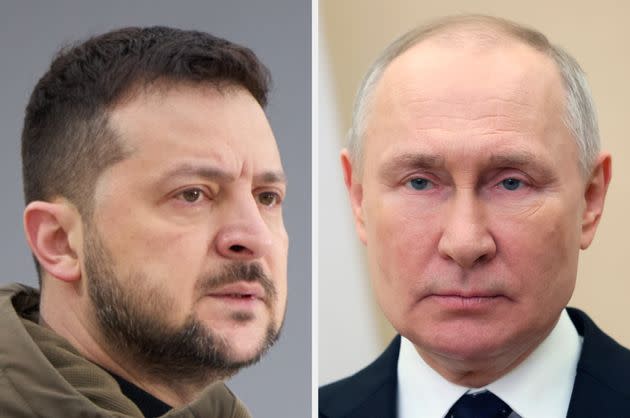
Ukrainian president Volodymyr Zelenskyy and his Russian counterpart, Vladimir Putin
A year after Russia first invaded Ukraine, and it still looks like there’s no end in sight.
As the war stretches into its second year, experts are divided over the next course of action.
Russia’s tactics have revolved around aggression and charging at Ukraine or sending indiscriminate air strikes, but these haven’t always worked.
There have been humiliating withdrawals and failed sieges, too.
Meanwhile, Ukraine has steadfastly held its ground with strong counter-offensives and hit and run strikes.
So, what might happen next?
A potential settlement?
This is pretty unlikely, as Ukraine wants to reclaim all of its land from pre-2014 before it will consider the war over – and it is not willing to budge.
That means Russia would not only have to retreat from the whole of the east – where all of its land grabs from the last year are – but also leave Crimea, the Ukrainian peninsula it illegally annexed almost a decade ago.
Russia has already tried revising its short-term war aims (for now at least) and is prioritising consolidating its grip over Ukraine’s east rather than trying to occupy the whole of country, as it originally intended.
So, handing back what little land it has seized would be humiliating.
Kateryna Stepanenko, a Russia research analyst at the Institute for the Study of War, also told HuffPost UK that Vladimir Putin’smost recent speeches have demonstrated that he has no plans to withdraw any time soon or stop pursuing seizing Kyiv – despite what he says.
She continued: “It is likely that Putin will blindly follow these goals.
“We should not fall for the Kremlin’s disinformation campaigns such as the December 2022 narrative that the ’Kremlin is open to negotiations with Ukraine’, despite not undertaking any serious efforts to do so or offering and concessions.”
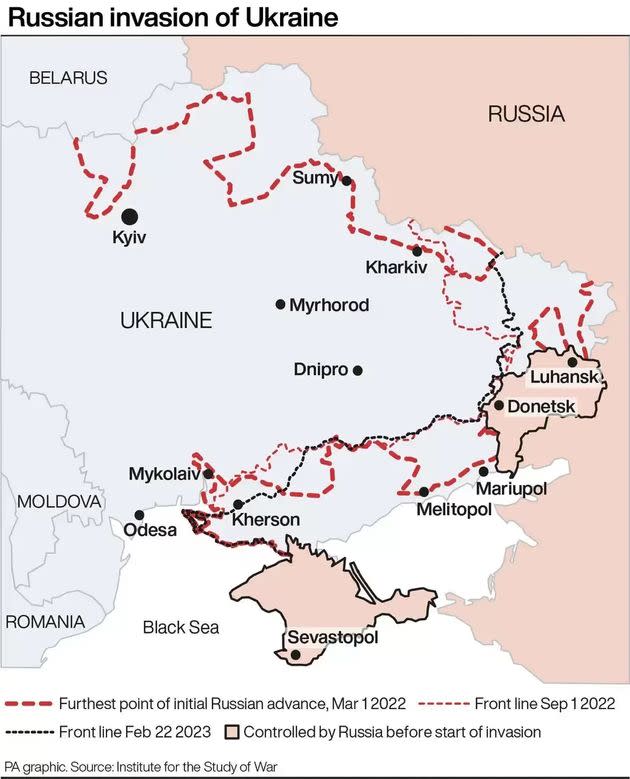
The frontline in the Russian-Ukrainian war
A new Russian attack?
There is a fear that Moscow could try to launch an attack anywhere along the 600-mile front line.
But, according to news agency AP, Igor Strelkov, a former Russian security officer who led separatists forces in Donbas, noted that a large offensive from Russia could be disastrous.
The preparation work would be too obvious, he claimed, meaning attackers would face a devastating response – much like when Moscow failed to capture Kyiv at the start of the war.
“Any large-scale offensive will quickly and inevitably entail very big losses, exhausting the resources accumulated during mobilisation,” Strelkov claimed.
Not everyone agrees.
“Russia currently has the initiative and the advantage on the battlefield,” Ukrainian military analyst Oleh Zhdanov told AP.
For now, it appears Russian forces are focusing on Bakhmut, a town which has become a symbol of tenacity for Ukraine.
Experts believe Russia wants to wear down the Ukrainian ranks with this particular conflict and distract them from other offensives – although this means depleting Russian troops, too.
Both sides have used up an astonishing amount of troops and weapons in this one battle, meaning it is a question of whose supplies will more exhausted first.
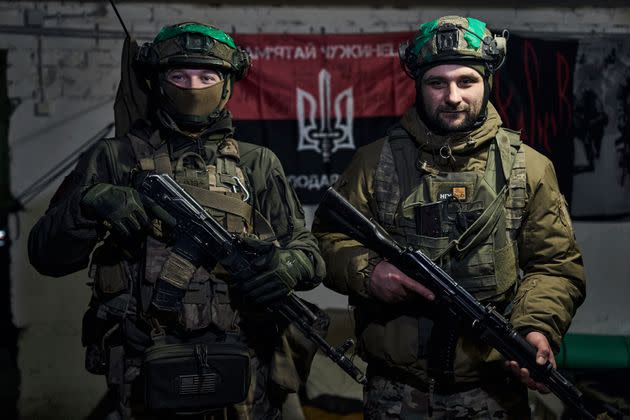
Ukrainian soldiers pose in a shelter in Bakhmut, Donetsk region, Ukraine, Tuesday, Feb. 21, 2023
A second Russian mobilisation?
Russia mobilised 300,000 reservists in September – and there are fears he could try to mobilise more.
However, Stepanenko told HuffPost UK that Putin seems hesitant to declare a second mobilisation wave.
She said this would suggest “he is rather concerned with the potential effects on his regime after additional force generation campaigns”.
Stepanenko explained that, although Russia’s defence minister Sergei Shoigu announced wide-ranging reforms to increase manpower in January, that won’t necessarily happen.
She added: “Putin is additionally reportedly conducting surveys to gauge Russians’ perception of mobilisation and has not made up his mind.”
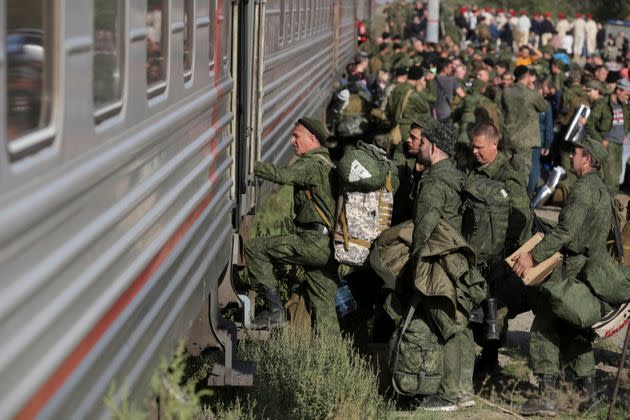
Russian recruits take a train at a railway station in Prudboi, in Russia’s Volgograd region, Thursday, Sept. 29, 2022. President Vladimir Putin announced a partial mobilisation, the first since World War II, amid the war in Ukraine.
A Ukrainian offensive?
Ukraine is currently waiting for the West to deliver on its promised tanks and new weapons, to help it best Russia. These will probably arrive in April or early May.
But, it has still spent ages working up brigades that had spearheaded the counter-offensives in Kharkiv and Kherson regions and suffered losses.
Think tank RUSI’s senior research fellow Justin Bronk, said that Ukraine has a window of opportunity of six to eight months to reclaim more land, as Russia may launch another mobilisation to recruit 500,000 more troops who would have had six months of training.
They will likely try to target the southern Ukrainian city of Zaporizhzhia, in a bid to cut the Russian corridor to Crimea – with analysts claiming if Ukraine reaches the Sea of Azov coast, Putin’s gains from 2022 will be undone.
If there are major successes for Ukraine in the upcoming months, then it could spell a problematic summer for Putin in the run-up to the regional elections.
What can we expect from Putin, domestically?
Stepanenko told HuffPost UK that Putin is reluctant to “take risks directly related to his conventional war” – so he probably won’t push the boat out much further to force a victory.
She said he only accepted the domestically unpopular policy of partial mobilisation after it was clear the Ukrainian successes from last summer would need to be countered by more manpower.
She noted that he could have called up a greater force than 300,000 but that would “damage his appeal” and he “evidently values his domestic status quo”.
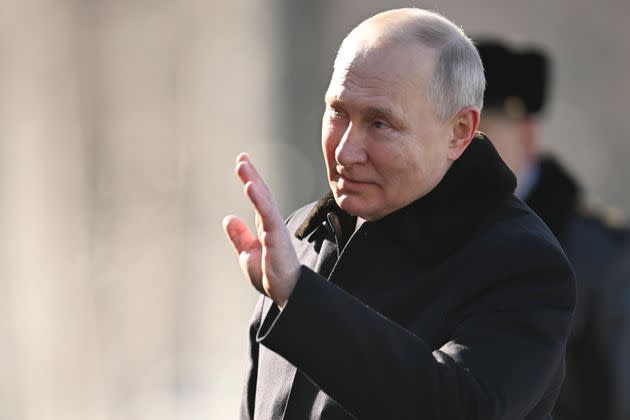
Russian President Vladimir Putin on Defender of the Fatherland Day" in Moscow, Russia, Thursday, Feb. 23, 2023.
Stepanenko continued: “Putin also did not formally declare martial law outside of Kherson, Zaporizhzhia, Donetsk, and Luhansk oblasts, but instead directed areas outside Ukraine to build out the legal framework necessary to support Russian mobilisation.”
She also explained how Putin tries to appeal to the “milbloggers” – online military writers who support the war and have a growing influence as mainstream sources of information on social media such as VK and Telegram – only sporadically.
She pointed to Putin’s strike campaign against Ukrainian energy infrastructure, and his refusal to implement clear Russian borders as evidence for this.
He instead wants to show he is a “calculated individual who places considerable emphasis on eliminating risks”.
So, he tends to articulate “maximalist and unrealistic objectives, calling on his government and military to achieve them”, but stops short of making the costly decisions they require, according to the analyst.
Could Russia really go nuclear?
While Putin has constantly threatened to go nuclear, promising to use “all available means” to protect what Russia considers its land, analysts are not so convinced.
“Putin remains even more unlikely to pursue nuclear escalation or war with Nato given his clear pattern of risk adversity during war in Ukraine,” Stepanenko explained.
“Russia uses nuclear threats primarily to intimidate the West and to undermine Ukrainian political and societal will to continue to oppose Russia’s invasion.
“Russian propagandists also make these nuclear threats as a way of reminding domestic audiences of Russia’s might amidst clear military failures on the frontlines.”
Even just targeting Ukrainian infrastructure with nuclear weapons would backfire, angering China and India, two of Putin’s few remaining allies.
Not everyone agrees, though.
Fiona Hill, senior fellow at the Brookings Institution, told AP: “Putin’s just hoping that everybody’s going to blink,” she said. “He’s not going to give up the idea that he could use a battlefield tactical nuclear weapon.”
But Ms Hill did add: “If he thought he would get the results that he wanted from it, he would use it.”

Russian invasion of Ukraine
So, what will bring the war to an end?
If Ukraine fails to reclaim more land and soon, it could lead to a “long-term stalemate and sort of a grinding attritional war that just kind of goes on and on,” according to RUSI’s Bronk.
He said that would play into the Kremlin plan to “prolong the war and just wait for the West to get exhausted”.
Hill suggested Russia is just banking on Western support fading away, if it cannot beat Ukraine in the field.
She said: “If that it goes away and that Ukraine is left exposed, and then Russia can force Ukraine to capitulate and give up on its territory.”
Related...
How Worried Should We Be About Putin's Latest Nuclear Threat?
How Entangled Is Putin's Fate With The Outcome Of The Russia-Ukraine War?
Britain Is Prepared To Supply Fighter Jets To Eastern European Allies, Ben Wallace Says

 Yahoo News
Yahoo News 